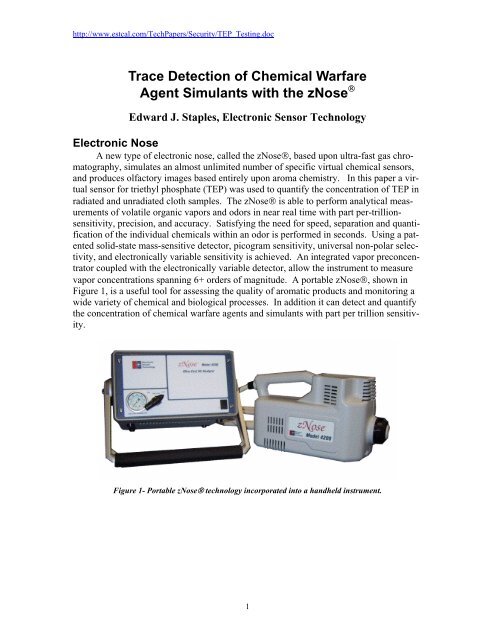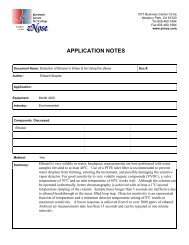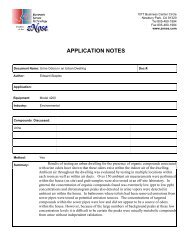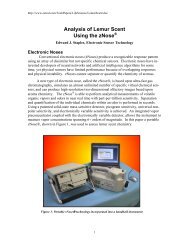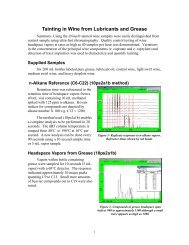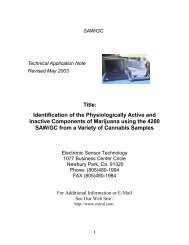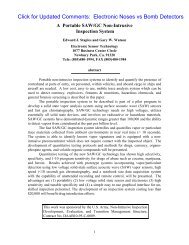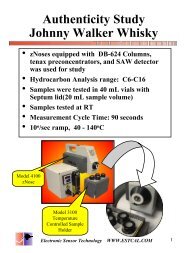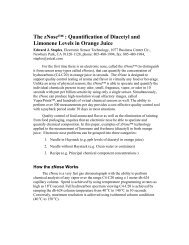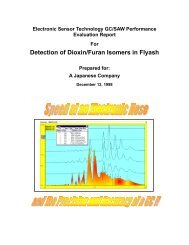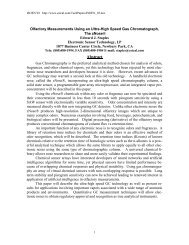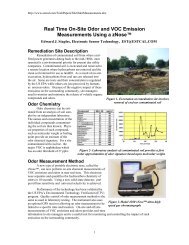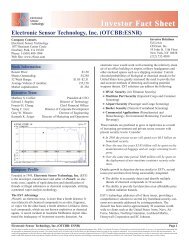Detecting energetic materials with the zNose - Electronic Sensor ...
Detecting energetic materials with the zNose - Electronic Sensor ...
Detecting energetic materials with the zNose - Electronic Sensor ...
Create successful ePaper yourself
Turn your PDF publications into a flip-book with our unique Google optimized e-Paper software.
http://www.estcal.com/TechPapers/Security/TEP_Testing.doc<br />
Trace Detection of Chemical Warfare<br />
Agent Simulants <strong>with</strong> <strong>the</strong> <strong>zNose</strong> ®<br />
Edward J. Staples, <strong>Electronic</strong> <strong>Sensor</strong> Technology<br />
<strong>Electronic</strong> Nose<br />
A new type of electronic nose, called <strong>the</strong> <strong>zNose</strong>®, based upon ultra-fast gas chromatography,<br />
simulates an almost unlimited number of specific virtual chemical sensors,<br />
and produces olfactory images based entirely upon aroma chemistry. In this paper a virtual<br />
sensor for triethyl phosphate (TEP) was used to quantify <strong>the</strong> concentration of TEP in<br />
radiated and unradiated cloth samples. The <strong>zNose</strong>® is able to perform analytical measurements<br />
of volatile organic vapors and odors in near real time <strong>with</strong> part per-trillionsensitivity,<br />
precision, and accuracy. Satisfying <strong>the</strong> need for speed, separation and quantification<br />
of <strong>the</strong> individual chemicals <strong>with</strong>in an odor is performed in seconds. Using a patented<br />
solid-state mass-sensitive detector, picogram sensitivity, universal non-polar selectivity,<br />
and electronically variable sensitivity is achieved. An integrated vapor preconcentrator<br />
coupled <strong>with</strong> <strong>the</strong> electronically variable detector, allow <strong>the</strong> instrument to measure<br />
vapor concentrations spanning 6+ orders of magnitude. A portable <strong>zNose</strong>®, shown in<br />
Figure 1, is a useful tool for assessing <strong>the</strong> quality of aromatic products and monitoring a<br />
wide variety of chemical and biological processes. In addition it can detect and quantify<br />
<strong>the</strong> concentration of chemical warfare agents and simulants <strong>with</strong> part per trillion sensitivity.<br />
Figure 1- Portable <strong>zNose</strong>® technology incorporated into a handheld instrument.<br />
1
http://www.estcal.com/TechPapers/Security/TEP_Testing.doc<br />
How <strong>the</strong> <strong>zNose</strong> Quantifies <strong>the</strong> Chemistry of Organic Vapors<br />
A simplified diagram of <strong>the</strong> <strong>zNose</strong>® system shown in Figure 2 consists of two<br />
parts. One section uses helium gas, a capillary tube (GC column) and a solid-state detector.<br />
The o<strong>the</strong>r section consists of a heated inlet and pump, which samples ambient air.<br />
Linking <strong>the</strong> two sections is a “loop” trap, which acts as a preconcentrator when placed in<br />
<strong>the</strong> air section (sample position) and as an injector when placed in <strong>the</strong> helium section (inject<br />
position). Operation is a two step<br />
process. Ambient air (vapor) is first sampled<br />
and organic compounds collected<br />
(preconcentrated) in <strong>the</strong> loop-trap. After<br />
sampling <strong>the</strong> trap is switched into <strong>the</strong><br />
helium section where <strong>the</strong> collected organic<br />
compounds are injected into <strong>the</strong> helium gas.<br />
The organic compounds pass through a<br />
capillary column <strong>with</strong> different velocities<br />
and thus individual chemicals exit <strong>the</strong><br />
column at characteristic times. As <strong>the</strong>y exit<br />
<strong>the</strong> column <strong>the</strong>y are detected and quantified<br />
by a solid state detector.<br />
An internal high speed gate array microprocessor<br />
controls <strong>the</strong> taking of sensor<br />
data which is transferred to a user interface<br />
or computer using an RS-232 or USB connection.<br />
Vapor chemistry, shown in Figure<br />
3, can be displayed as a sensor spectrum or<br />
a polar olfactory image of odor intensity vs<br />
Figure 2- Simplified diagram of <strong>the</strong> <strong>zNose</strong><br />
showing an air section on <strong>the</strong> right and a helium<br />
section on <strong>the</strong> left. A loop trap preconcentrates<br />
organics from ambient air in <strong>the</strong><br />
sample position and injects <strong>the</strong>m into <strong>the</strong> helium<br />
section when in <strong>the</strong> inject position.<br />
retention time. Calibration is accomplished using a single n-alkane vapor standard. A<br />
library of retention times of known chemicals indexed to <strong>the</strong> n-alkane response (Kovats<br />
indices) allows for machine independent measurement and compound identification.<br />
Figure 3- <strong>Sensor</strong> response to n-alkane vapor standard, here C6-C14, can be<br />
displayed as sensor output vs time or its polar equivalent olfactory image.<br />
2
http://www.estcal.com/TechPapers/Security/TEP_Testing.doc<br />
Chemical Analysis (Chromatography)<br />
The time derivative of <strong>the</strong> sensor<br />
spectrum (Figure 3) yields <strong>the</strong><br />
spectrum of column flux, commonly<br />
referred to as a chromatogram. The<br />
chromatogram response (Figure 4) of<br />
n-alkane vapors (C6 to C14) provides<br />
an accurate measure of retention<br />
times. Graphically defined regions<br />
shown as red bands calibrate<br />
<strong>the</strong> system and provides a reference<br />
time base against which subsequent<br />
chemical responses are compared or<br />
indexed. As an example, a response<br />
midway between C10 and C11 would<br />
have an retention time index of 1050.<br />
Triethyl Phosphate<br />
Figure 4- Chromatogram of n-alkane vapors C6 to C14).<br />
Triethyl phosphate is a clear, colorless liquid <strong>with</strong> a light odor. It has a density of<br />
1.07, a molecular weight of 182.16, a boiling point of 216 o C, and a vapor density of 6.3.<br />
The molecular formula is (C2H5O)3PO and its chemical structure is shown in Figure 5.<br />
Triethyl phosphate (TEP) is often used as a simulant for G agents such as TABUN,<br />
SARIN, SOMAN, and GF and to define lethality scaling between <strong>the</strong> simulants and <strong>the</strong><br />
actual agents. TEP can also be used as a chemical warfare agent simulant to evaluate <strong>the</strong><br />
penetration characteristics of clothing, gloves, boots and items of personal equipment.<br />
Figure 5- Chemical structure of<br />
triethyl phosphate.<br />
Figure 6- Testing for clothing contaminated <strong>with</strong> chemical agent<br />
simulants during a training exercise .<br />
3
http://www.estcal.com/TechPapers/Security/TEP_Testing.doc<br />
ZNose ® Calibration and Sensitivity<br />
The <strong>zNose</strong> ® utilizes ultra-fast gas chromatography<br />
to speciate and quantify vapor<br />
concentrations of TEP in just 10 seconds<br />
(Figure 7). A solid-state SAW detector <strong>with</strong><br />
electronically variable sensitivity allows <strong>the</strong><br />
instrument to operate over a wide range of<br />
TEP vapor concentrations.<br />
The instrument was calibrated by directly<br />
injecting 0.2 µl of methanol containing<br />
1072 picograms of TEP The sample was<br />
concentrated, injected, and chromatographed<br />
using a db5 column ramped from 40 o C to<br />
180 o C at 10 o C/second. Calibration results<br />
using SAW detector temperatures of 20 o C,<br />
40 o C, and 60 o C are shown in Figure 8. With<br />
a 20 o C detector, <strong>the</strong> minimum detectable<br />
amount of TEP was approximately 10 picograms. Sampling ambient air for just 10 seconds,<br />
<strong>the</strong> <strong>zNose</strong> ® Figure 7- Vertically offset TEP chromatograms<br />
achieved a minimum detection level for TEP of 1 part per billion (8<br />
nanograms/liter). Lower detector temperatures and/or longer sampling times can be<br />
used to achieve part per trillion sensitivity.<br />
Figure 8- Sensitivity vs SAW detector temperature.<br />
4
http://www.estcal.com/TechPapers/Security/TEP_Testing.doc<br />
Sample Preparation<br />
Simulating exposure to CW agents, five cloth samples were inoculated <strong>with</strong> 25 µL<br />
of TEP and <strong>the</strong>n irradiated in a chamber for 1,3,5,7 and 9 minutes. Four control samples<br />
(C0,C1,C5, and C9) were inoculated, placed in chamber for 0,1,5, and 9 minutes <strong>with</strong>out<br />
radiation. All samples were stored in sealed plastic ampoules prior to being tested for<br />
TEP.<br />
Test Method<br />
Each cloth sample was removed and placed in a 40 mL septa sealed vial containing<br />
10 mL of methanol to extract TEP from <strong>the</strong> sample (Figure 9). A small fraction (
http://www.estcal.com/TechPapers/Security/TEP_Testing.doc<br />
Test Results<br />
Cloth samples containing TEP showed decreasing amounts of TEP <strong>with</strong> increasing<br />
radiation time as shown in <strong>the</strong> chromatograms of Figure 11. This is confirmed by a plot<br />
Figure 11- Vertically offset chromatograms from radiated cloth samples showing decrease<br />
in TEP concentration <strong>with</strong> radiation time.<br />
of TEP concentration vs radiation time shown in Figure 12. The concentration of TEP in<br />
<strong>the</strong> control samples and spiked methanol solution are shown for comparison.<br />
Figure 12- TEP concentration vs radiation time.<br />
6
http://www.estcal.com/TechPapers/Security/TEP_Testing.doc<br />
Summary<br />
The <strong>zNose</strong> ® answers <strong>the</strong> need for real-time-speed, precision, accuracy and portability<br />
in <strong>the</strong> detection and chemical analysis of chemical warfare agents. Performance of <strong>the</strong><br />
<strong>zNose</strong> ® was testing using triethyl phosphate, a simulant for G agents TABUN, SARIN,<br />
and SOMAN. Part per billion sensitivity was easily achieved <strong>with</strong> 10 second analysis<br />
time. Extended sampling times and lower detector temperatures allow <strong>the</strong> system to<br />
achieve even lower , part per trillion, detection limits. Although <strong>the</strong> <strong>zNose</strong> ® contains<br />
only a single physical sensor, <strong>the</strong> ability to perform high-speed chromatography enables<br />
it to functionally perform as if it were an array of specific chemical sensors. Literally<br />
hundreds of virtual chemical sensors can be created covering a wide array of chemical<br />
warfare agents.<br />
An investigation of a chemical warfare agent remediation process using cloth samples<br />
inoculated <strong>with</strong> TEP was carried out. Radiated and unradiated control samples were<br />
tested and results showed nearly complete removal of TEP could be achieved in less than<br />
10 minutes.<br />
The ability to perform hundreds of chromatographic analyses per day provides a<br />
cost-effective solution to sample screening and process development in laboratory and<br />
field environments alike. This was demonstrated by <strong>the</strong> testing of all radiated and nonradiated<br />
samples containing TEP in less than 1 hour. Whereas such projects can often<br />
take weeks using a conventional instruments, <strong>with</strong> <strong>the</strong> <strong>zNose</strong>® it is possible to complete<br />
project investigations in less than a day. It is not difficult to see how <strong>the</strong> <strong>zNose</strong>® pays<br />
for itself in less than 30 days..<br />
7


